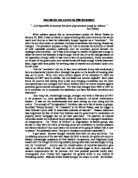Problems began with the decision to go to war with Japan, which was influenced by Russia’s economic ambitions in the Far East and the fell that victory would stem the tide of revolutionary dedication back home. However, due to military weakness, problems with communications and underestimating the power of the Japanese plagued the Russian war effort. The early fall of the Naval base at Port Arthur was followed by the major defeat on land at Mukden. Finally, to add more insult there was the destruction of the Russian Baltic Fleet in May 27th 1905. The Russians had failed in both the water and land along with the Russian Government reputation in the eyes of the nation.
Another incident, which provoked the need for revolution, was ‘Bloody Sunday’. Moscow’s chief police Colonel Zubatov had organized a brave campaign experiment by encouraging moderate workers groups to campaign for better wages and working conditions in an effort to distract them from terrorism and revolution. However, despite its efforts it backfired violently and pushed more reason for a revolution. An Orthodox priest Father Gapon had been acting as a police agent in charge of one of these groups, The Assembly of Russian Factory Workers, when news of the failure at Port Arthur provoked widespread unrest in St Petersburg. He organized a petition to the Tsar demanding an elected assembly, minimum wage and the abolition of redemption repayments and led a march on the winter palace to air his criticism. More than 15,000 people, who at the arrival met police and soldiers who tried to push them away. Doing so they failed and panicked, resulting in them opening fire on the protesters, killing several hundred people. Although Nicholas was not at the palace, it was widely believed that it was the Tsar who had given the order to open fire on the demonstrators. This totally alienated the crowd from the crown.
The government remained confident and determined, as any sign of weakness would encourage the opposition to keep fighting. Nicholas made as few concessions as possible Witte, the new Chief Minister, advised to make concessions. He eventually agreed and published the October Manifesto. This granted freedom of conscience, speech, meeting and association. He also promised that in future people would not be imprisoned without trial. Finally, he announced that no law would become operative without the approval of the . He would also need the approval of the middle class people of Russia to maintain him power.
Professional men and many members of the zemstva were liberal reformers. They opposed the idea of a revolution to overthrow Tsardom. Some of them (the rightwing Liberals) hoped to establish a consultative representative body in the central government so that the Tsar could always consult the people's representatives. Some of them (the leftwing Liberals) were more radical. They wanted the establishment of a constitutional monarchy, with universal, secret and direct suffrage.
The Tsar also had control over the Army meaning he was still able to retain power over the people. Despite there failure against the way with Japan, it gave the Tsar more influence amongst the people. In my opinion, the Tsar survived the revolution because despite a few naval incidents the army remained loyal enough to support him throughout and to crush his opposition.
What seems to be clear is that the ability of the Tsar and his government to ride out the problems of 1905 was, in spirit, their pulling themselves together and effectively dealing with the situation in hand. Concessions were made where they were needed, none of which seriously damaged or altered the Tsar’s power, and force stepped in where political pacification did not placate. The government acted effectively in the face of combining external issues, dealt with them to the extent of sending most of the general population back to work and away from governmental necks (despite a few assassinations), and, while perhaps not emerging unscathed, emerged nonetheless. The revolution, if that is what it truly was, was a rebellion driven by displeasure with living—not discontent directed squarely at the government in and of itself.






